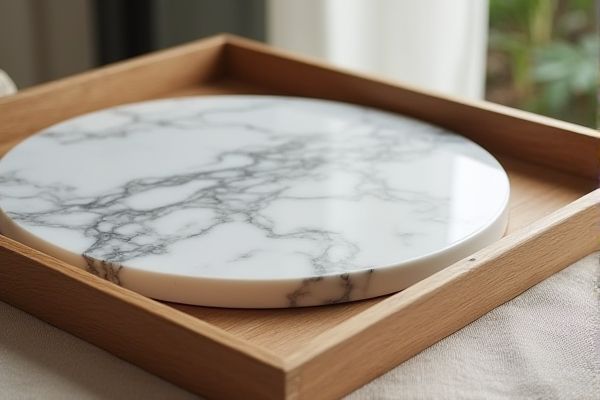
Marble trays offer a sleek, durable surface that resists heat and stains, making them ideal for serving or decorative purposes, while wooden trays provide a warm, rustic aesthetic with a lighter weight and natural texture that complements various interior styles. Discover how to choose the perfect tray for your needs by exploring the benefits and drawbacks of each material in the rest of this article.
Table of Comparison
| Feature | Marble Tray | Wooden Tray |
|---|---|---|
| Material | Natural stone (marble) | Natural wood (various types) |
| Durability | Highly durable, resistant to scratches and heat | Moderately durable, prone to scratches and water damage |
| Weight | Heavy | Light to medium weight |
| Design | Sleek, elegant, glossy finish | Rustic, natural, variety of textures |
| Maintenance | Easy to clean, requires sealing to prevent stains | Needs regular oiling and careful cleaning |
| Price | Generally expensive | Affordable to mid-range |
| Usage | Ideal for serving cold items, decorative use | Versatile for serving and decoration |
Introduction to Marble Trays and Wooden Trays
Marble trays offer a luxurious, durable surface known for its natural veining and resistance to heat and scratches, making them ideal for serving or decorative use. Wooden trays provide a warm, rustic aesthetic with lightweight versatility and the ability to absorb moisture, often preferred for casual settings and eco-friendly options. Choosing between a marble tray and a wooden tray depends on your preference for elegance and durability versus natural charm and practicality.
Aesthetic Differences: Marble vs Wooden Trays
Marble trays showcase a sleek, polished surface with natural veining patterns that exude luxury and timeless elegance, enhancing any modern or classic decor. Wooden trays offer warm, organic textures with unique grain variations, creating a cozy, rustic ambiance ideal for casual or traditional settings. Your choice between marble and wooden trays hinges on whether you prefer a sophisticated statement piece or a natural, inviting aesthetic.
Durability Comparison: Marble and Wood
Marble trays are highly durable, resistant to scratches, heat, and stains, making them ideal for long-term use in kitchens or serving settings. Wooden trays, while aesthetically pleasing and lightweight, are more prone to dents, water damage, and wear over time unless properly treated and maintained. You should choose a marble tray for lasting strength and a wooden tray for a warm, natural look with moderate durability.
Maintenance and Cleaning Requirements
Marble trays require careful maintenance to prevent staining and etching, often needing gentle cleaning with mild soap and a soft cloth while avoiding acidic or abrasive cleaners. Wooden trays demand regular oiling or waxing to preserve their finish and protect against water damage, along with wiping spills promptly to prevent warping or cracking. Your choice depends on how much time you're willing to dedicate to upkeep, as marble offers durability but is sensitive to acids, while wood offers warmth with ongoing conditioning needs.
Weight and Portability Considerations
Marble trays are significantly heavier than wooden trays, making them less portable but more stable for holding items securely. Wooden trays offer lightweight convenience, ideal for easy carrying and frequent movement around your home or office. Your choice depends on whether you prioritize durability and heft or ease of handling and transport.
Functionality: Best Uses for Marble and Wooden Trays
Marble trays excel in serving hot dishes or drinks due to their heat resistance and durability, making them ideal for kitchen or dining room use. Wooden trays offer lightweight portability and a natural aesthetic, perfect for breakfast in bed, serving snacks, or outdoor gatherings. Both materials provide distinct functional advantages based on temperature management and transport convenience.
Eco-Friendliness and Sustainability
Marble trays are durable and long-lasting but require energy-intensive quarrying processes that impact the environment. Wooden trays, especially those made from sustainably sourced or reclaimed wood, offer a renewable and biodegradable option that minimizes carbon footprint. Choosing wooden trays supports your commitment to eco-friendliness and sustainability by promoting responsible resource use and reducing waste.
Price Range and Affordability
Marble trays typically range from $50 to $150, reflecting their durability and elegant appearance, while wooden trays generally cost between $20 and $80, offering a more budget-friendly option. The natural variation in wood types and finishes allows wooden trays to cater to diverse price points and styles, making them accessible for most budgets. Your choice depends on whether you prioritize the luxurious, long-lasting qualities of marble or the versatile, affordable appeal of wood.
Popular Styles and Design Trends
Marble trays often showcase sleek, minimalist designs with natural veining patterns that complement modern and luxury interiors, while wooden trays highlight rustic, farmhouse, or bohemian styles featuring carved details and natural wood grains. Popular design trends for marble trays include monochromatic palettes and geometric shapes, enhancing their elegance and versatility in upscale settings. Wooden trays trend towards eco-friendly finishes and handcrafted aesthetics, catering to sustainable and artisanal decor movements in contemporary homes.
Which Tray is Right for You?
Marble trays offer durability, a sleek aesthetic, and cool temperature retention, making them ideal for serving cold items or as elegant decor pieces. Wooden trays provide a warm, natural look, are lightweight, and easier to handle, perfect for everyday use and rustic settings. Choose marble for style and sturdiness in formal environments, or wooden for practicality and a casual, cozy atmosphere.
 homyna.com
homyna.com